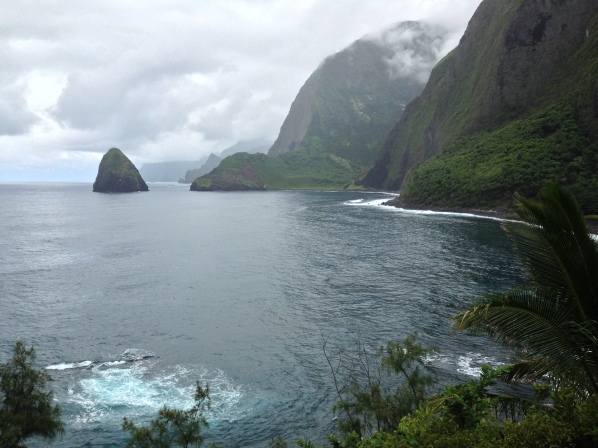The Kaluapapa peninsula, created by an underwater oceanic volcanic eruption on the central north shore of Moloka`i, is one of the most isolated places in all of the Hawai`ian Islands.
Cliffs of 2,000 feet and higher, created by a gigantic landslide whose rubble extends 40 miles out on the ocean floor, are some of the highest ocean cliffs in the world. No roads lead to the peninsula.
In this setting, in 1866, the Kingdom of Hawai`i relocated by ship and essentially abandoned thousands of Hawai`ians who had contracted Hansen’s disease (leprosy). Leprosy is a bacterial disease with a low transmission rate, but was not well understood in the late 19th century. Only 5% of humans have the genetic pre-disposition to the disease. In the end 8,000 persons either those with the disease, their helpers or family members who refused to be separated from them, lived at the peninsula.
It is this location and social drama, that attracted the Belgian Catholic priest, Father – now Saint Damien, to come to care and minister to the residents in 1873 until his death from the disease. A German-American nun, now Saint Marianne Cope, from Utica, NY also came to the colony to care for the people there. The featured image is of the haunting little church, graveyard, and former grave of Father Damien on the now abandoned site of the original settlement on the east side of the peninsula looking down the forbidding north coast cliffs of Moloka`i. Robert Louis Stevenson called the place ‘a prison fortified by nature’.
The only access to the peninsula is by guided tour, but you have to get there by plane, mule, or on foot! Jessica and I hiked the 3.5 mile super steep trail with 26 switchbacks that almost jumps down the 1,700 foot cliff to the beach and the village. Then back up in 1.5 hours in the late afternoon, hot, but in the cooling rain showers! The surefooted mules and their tourist riders passed us on the way back up.
You can get a feel for the scale of the cliffs by spotting Jessica down the trail.
The trail has 1,000s of steps, all carefully paved with concrete cross bricks to control erosion, what a immense amount of labor!
After 2 hours of down, down, the trail emerges from the forest along a spectacular and empty beach.
There are only 15 residents left in the village, along with 85 other workers for the National Park Service, the county road department, the airfield, store, clinic, family members, and the local Catholic priest (Irish from Boston!). When the lifetime residents pass on, there will be a discussion about what entity manages the peninsula. Many hope that Hawai`ian Homelands will have some say to protect the historical significance of the place.
It is a beautiful place, but one with plenty of spirits and sorrow, with abandoned buildings and fields.
The view from the isolated church looks out along the intense and inaccessible north cliffs, extending all the way around to Halawi at the east end of the island.
When we left the island the next day, the plane flew over the north side cliffs and there was a beautiful double rainbow!
Aloha










You have had such a wonderful tour of the Islands that few would never imagine! Thank you for sharing!
LikeLike
Made all the better by your and Bob’s visit with us!
LikeLike